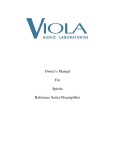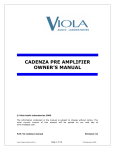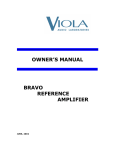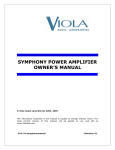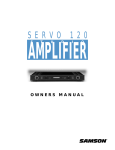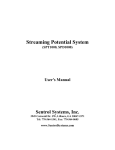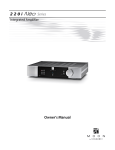Download Viola Systems LEGACY Owner`s manual
Transcript
--------------------------------------------------------------------------- LEGACY MONO POWER AMPLIFIER OWNER’S MANUAL ------------------------------------------------------------------------------- © Viola Audio Laboratories 2009 The information contained in the manual is subject to change without notice. The most current version of this manual will be posted on our web site at www.Violalabs.com. P/N: 91-legacymanual Revision: 0 TABLE OF CONTENTS • Safety Instructions 3 • Introduction 4 • Unpacking 4 • Voltage Setting 4 • Location 5 • XLR Connector Pin Assignment 5 • Speaker Cable Connection 6 o Single Speaker Cable Connection 6 o Bi-wiring Speaker Connection 7 • Multi-amplification 7 • AC Power Cable Connection 8 • Switching on for the First Time 8 • Remote On – Off 8 • Breaking In 9 • Care and Cleaning 9 • Mains Fuse 9 • Troubleshooting 10 • Warranty 11 • Service 12 • Contacting VIOLA 13 • Specifications 14 Viola Legacy Manual Rev 0 Page 2 of 14 14th February 2009 IMPORTANT SAFETY INSTRUCTIONS Please read all of the following instructions before operating your power amplifier. 1. This product contains no user serviceable parts. NEVER attempt to repair the unit yourself. Refer all servicing to a VIOLA approved technician. 2. This product must be connected to the mains supply with a threeconductor AC mains power cord that includes a ground connection. To prevent shock hazard, all three connections must ALWAYS be used. NEVER defeat the ground connection. 3. ALWAYS disconnect your entire system from the AC mains before connecting or disconnecting any cables, or before cleaning any component. 4. NEVER operate this unit with any covers removed. Dangerous voltages may exist within the unit even when it is disconnected from the mains supply. 5. We do not recommend the use of AC extension cords with this product. If it is necessary to use an extension cord, please ensure that it meets the safety standards in your country and has sufficient current capacity. For 100V to 120V operation, use a cable with at least a 10A rating. For 220V to 240V operation, use a cable with at least a 5A rating. 6. NEVER use flammable chemicals for cleaning this product. 7. NEVER wet the inside of this product with any liquid, or operate the unit in a wet environment. 8. NEVER block air flow through the ventilation slots on either the top or the bottom of the unit. 9. NEVER bypass any fuses. 10. NEVER replace any fuse with a value or type other than those specified. Suitable replacements are available from your local VIOLA dealer, national distributor or directly from VIOLA. 11. NEVER expose this product to temperatures outside the range 0°C to 55°C, non-condensing. 12. ALWAYS disconnect the unit from the mains supply during lightning storms, or if the unit will not be used for a prolonged period. Viola Legacy Manual Rev 0 Page 3 of 14 14th February 2009 INTRODUCTION Thank you for choosing the VIOLA Legacy Amplifier. Great care has gone into the design and manufacture of the Legacy and if properly used, it will give a lifetime of musical enjoyment. We strongly recommend that you read these instructions before you attempt to use the unit, so that you can be sure it is set up to give optimum performance. UNPACKING Please keep all of the packing materials in case you ever need to ship the unit. Should you need to return the unit to the factory, you must use the original shipping carton. The use of any other packing may result in the product sustaining damage in transit. Such damage is not covered by the warranty. Replacement shipping cartons may be obtained via your VIOLA dealer, national distributor or directly from the factory. After unpacking the unit, please confirm that the following items are present: 1 1 1 1 2 VIOLA Legacy power amplifier user manual three-conductor mains cord Remote Cable Spare Fuses If any of the above items are missing, or if the amplifiers show any signs of damage, please contact your VIOLA dealer immediately. VOLTAGE SETTING Before going any further please, confirm that the unit is set to operate on the mains voltage you plan to use. The setting is indicated on the fuse cover. This is on the mains input receptacle located on the unit’s rear panel. Please see the section on the MAINS FUSE for more details. If the setting on your unit is not correct, contact your VIOLA dealer. Only a VIOLA approved technician should change the voltage setting. Do not attempt to do this yourself. Should you set the unit to the wrong voltage, you risk personal injury and you may also cause serious damage to the unit which will void the warranty. Viola Legacy Manual Rev 0 Page 4 of 14 14th February 2009 LOCATION We recommend that you place the Legacy as close to the loudspeaker as possible, as this reduces the length of speaker cable required. While this may make it necessary to use longer interconnect cables, long interconnects cause less sonic degradation than long speaker cables. The unit may be placed on a stand or shelf, provided it is strong enough. Alternatively, it may be placed directly on the floor. In this case, please ensure that that the ventilation slots on the base of the unit are not obstructed by carpeting or other floor covering. Never stack Legacy units on top of each other or place them on top of another power amplifier, or other source of heat. Always allow a clearance of at least 3.5” (5cm) above the unit. You must also allow a clearance of at least 6” (15 cm) behind the unit, to enable the cables to be routed without being subject undue strain. Regardless of where you locate your amplifier, we advise positioning it well away from sensitive low signal level components such as pre-amplifiers and turntables. The Legacy power amplifier dissipates approximately 400 watts as heat when idling (i.e. no input signal). It is normal and perfectly safe for it to run hot to the touch. XLR CONNECTOR PIN ASSIGNMENT The Legacy is fitted with 2 XLR type balanced inputs. The pin assignments of the Legacy’s XLR input conforms to the AES 14 standard, which is now commonly used throughout the audio industry. These assignments are shown below: Pin 1: Pin 2: Pin 3: Connector shell: Signal ground Signal + (non-inverting) Signal - (inverting) Chassis ground Some equipment may have the polarity of the signals on pins 2 and 3 of the XLR connectors swapped over. Please refer to the user manuals of the other equipment in your signal chain to confirm whether this is the case. If this is the case, it will not cause any damage, but it may reduce the quality of the stereo image, as well as the perceived attack of the bass. This situation is easily remedied by swapping the connections of pins 2 and 3 at either end of one of one set of balanced cables in the signal chain. Alternatively you can swap over the polarity Viola Legacy Manual Rev 0 Page 5 of 14 14th February 2009 of the speaker leads on both channels. Your dealer should be able to advise you on the best course of action. If two items in the signal path have the connections to pins 2 and 3 of the XLR connector reversed with respect to the AES standard, this cancels out the problem and you need take no further action. SPEAKER CABLE CONNECTION Caution! • NEVER connect a power amplifier's output terminals to any device other than a loudspeaker. • NEVER short-circuit the amplifier's output terminals. • ALWAYS switch the amplifier off before connecting or disconnecting signal or speaker cables. CABLES AND CONNECTORS To realize the full potential of the Legacy, we recommend the use of a high-quality speaker cable such as the VIOLA Jazz cable. Consult your VIOLA dealer for details. The Legacy is equipped with four pair of high quality binding posts. These are designed to accept cables fitted with spade lugs. The lugs should either be soldered or crimped to the speaker cable – the latter is preferred. We do not recommend the use of bare wire to connect the speaker cable to the binding post. This produces an inferior connection that degrades as the bare conductors become tarnished. SINGLE SPEAKER CABLE CONNECTION WARNING: The Legacy uses a balanced output connection. There is voltage on both the plus and minus terminals. Do not ground any output connection. Connect red (H) binding post on the rear of the Legacy to the input terminal marked +, or colored red on the speaker. Connect the black (L) binding post on the rear of the Legacy to the input terminal marked -, or colored black on the speaker. Use the impedance tap that best matches your speaker. If you have a nominal 8 Ω speaker use the 8 Ω connection. Viola Legacy Manual Rev 0 Page 6 of 14 14th February 2009 BI-WIRE CONNECTION Bi-wireable speakers have separate inputs for the high frequency (HF) and low frequency (LF) sections of their cross-overs. These are connected to the power amplifier with separate speaker cables. Bi-wire connection is regarded as superior to using a single cable, as it avoids interactions between the low and high frequencies that may occur when a single speaker cable is used. You will require two sets of speaker cables. To use a bi-wire speaker with the Legacy follow the instructions below: 1. Connect the terminal marked +, or colored red on the speaker’s LF input to the red (H) binding post on the rear of the Legacy. 2. Using a separate cable, connect the terminal marked +, or colored red on the speaker’s HF input to the red (H) binding post on the rear of the Legacy. 3. Connect the terminal marked -, or colored black on the speaker’s LF input to the black (L) binding post on the rear of the Legacy. 4. Using a separate cable, connect the terminal marked -, or colored black on the speaker’s HF input to the black (L) binding post on the rear of the Legacy. Note: Bi-wireable speakers are often shipped with links between the inputs to the two sections of the cross-over. Ensure that these links are removed, or the benefits of bi-wiring will not be realized. MULTI-AMPLIFICATION Multi-amplification (or multi-amping) uses separate power amplifiers to drive the input to each section of the speaker. This reduces the interaction not only between the upper and lower frequencies, but also between the left and right channels. There are two types of multi-amped system. The most common type uses the speaker’s internal cross-over. One amplifier is used to drive each section of the speaker’s cross-over directly. A 2-way speaker will therefore use 2 Legacy amplifiers and a 3-way speaker will use 3 Legacy amplifiers. All the amplifiers on one channel must be driven by the same signal. This is easily arranged as the Legacy has two XLR input connectors and these are wired in parallel. The pre-amplifier is connected directly to one Legacy and then the second input on this unit is connected to one of the inputs on next amplifier in that channel. Additional amplifiers are linked in the same manner. In the second type of multi-amped system, the speaker’s internal cross-over is not used. Each driver is driven directly by its own dedicated Legacy amplifier. The input signal is split into the bands appropriate for each driver using an electronic crossover such as the VIOLA Quartet or Duet and the outputs from this device are used to drive each Legacy. Splitting the input signal into the necessary bands at low level allows distortion levels to be reduced compared to when a conventional cross-over is used. Viola Legacy Manual Rev 0 Page 7 of 14 14th February 2009 For more information about the VIOLA Quartet or Duet please visit the VIOLA web site at www.violalabs.com. AC POWER CABLE CONNECTION If the wall outlet you plan to use for the Legacy has an on/off switch, check that it is switched off. Insert the supplied AC mains cord into the receptacle on the rear of the Legacy and ensure that it is pushed securely home. Insert the other end of the mains cable securely into the mains outlet. Take care to arrange the cable so that it is not bent sharply and that its weight will not pull it out of either the mains outlet, or the receptacle on the rear of the Legacy. Do not switch the unit on yet. SWITCHING ON FOR THE FIRST TIME Check that all the signal cables in the system are correctly connected. Select the appropriate input on the pre-amplifier and set the volume to minimum. Switch on the pre-amplifier and your signal source, which we will assume is a CD player. Allow the system to stabilize for 2 minutes, and then put a CD into the player and press play. If the wall outlet you are using for the Legacy is switchable, switch it on now. The LED will be a dim green. This tells you the Legacy has AC power and is in standby mode. The Legacy consumes less than a ½ Watt in standby. Press the power switch on the Legacy’s front panel. When the unit starts, the LED will increase in brightness. Allow the unit to stabilize for 2 minutes, and then slowly increase the volume on the pre-amplifier to a comfortable level. The unit is now ready for use. If you experience any problems, please refer to the trouble shooting section of this manual. REMOTE ON - OFF The Legacy can be remotely turned off and on by a +12 Volt DC signal feed into the remote in jack on the back of the Legacy. You can turn on multiple Legacy amplifiers Viola Legacy Manual Rev 0 Page 8 of 14 14th February 2009 by connecting from the remote out jack of the first amplifier into the remote in jack of the second. BREAKING IN Although the VIOLA Legacy power amplifier will deliver outstanding performance straight out of the box, you may expect to hear it continue to improve as it reaches its normal operating temperature and its various components "break-in." It has been our experience that the greatest changes occur within the first 25-50 hours. The amplifier will continue to improve in sound quality for about 300 hours from the start of use. The only exception to this rule is if the unit is switched off, allowing it to cool down. In this case, a brief warm-up period will be required before the amplifier's sound quality reaches its best. It is not necessary to repeat the initial 300 hour break-in. We recommend that you turn off the Legacy when not in use. Since it is a Class A bias amplifier it will dissipate the most heat when idle. CARE AND CLEANING Caution! • ALWAYS switch the amplifier off and disconnect it from the mains supply before attempting to clean it. • NEVER apply cleaning products directly to the amplifier as they may enter the unit and cause damage. • NEVER use any of the following cleaning products as they may damage the finish: • Wax polish • Spirit or alcohol based cleaners • Corrosive or abrasive cleaners In most cases wiping the unit with a slightly damp soft cloth will give satisfactory results. Non-abrasive glass cleaners containing ammonia or vinegar, applied with a soft cloth may also be used. If you have concerns about the suitably of a cleaner, first try it out on a part of the unit that is less visible, such as the rear panel. MAINS FUSE The mains fuse is located inside the mains input receptacle on the unit’s rear panel. If you suspect that the fuse has blown, follow the procedure below: • Disconnect the amplifier from the mains supply. • Check the fuse with a continuity tester and replace any blown fuses with one of the rating and type shown below. Using a fuse of the Viola Legacy Manual Rev 0 Page 9 of 14 14th February 2009 incorrect type or rating may create a safety hazard or cause damage to the unit and may also result in the warranty being voided. Operating Voltage 100V, 110V or 120V 220V or 240V Fuse Rating T6.25A T3.15A Fuse Size 11/4 inch 5mm x 20mm 2 spare fuses are supplied with the amplifier. Suitable replacements may be obtained from your VIOLA dealer or directly from VIOLA. • After replacing the fuse, switch the amplifier on and check whether it operates normally. If the fuse blows again, switch the unit off immediately, disconnect it from the mains supply and get in touch with your VIOLA dealer, national distributor or VIOLA directly for technical support. Contact details for VIOLA are given in the GETTING IN TOUCH section of this manual. TROUBLE SHOOTING Most problems may be resolved by following the steps below. If these fail, please contact your VIOLA dealer, national distributor or VIOLA directly. 1. No sound and the front panel LED is not lit? • Press the front panel power switch to confirm that the unit is not switched off. If there has been a temporary interruption to the mains supply, or the supply voltage has dropped below certain limits, the unit will automatically shut down and cannot be restarted until the mains voltage returns within the normal operating range. The drop-out voltage and normal operating range for 120V and 240V units are shown below. Mains Setting 120V 240V Drop Out Voltage 90V 190V Normal Operating Range 90V – 140V 190V – 280V • Check that the power lead is inserted all the way into the AC input receptacle on the rear panel, the other end is plugged into the AC wall outlet and if applicable, that the wall socket is switched on. • Check that there is power on the AC wall socket by connecting another piece of equipment that is known to work to the socket. • Check the mains fuse as shown in the MAINS FUSE section of this manual. 2. No sound and the front panel LED is lit? • Check the entire signal wiring in the system. • Check that all the units feeding the amplifier are switched on. Viola Legacy Manual Rev 0 Page 10 of 14 14th February 2009 • Check that the input selector and any other relevant switches are set appropriately. • Check that the signal source is playing. • Check that the pre-amplifier and or signal source volume control(s) are set at a level that is loud enough to hear. 3. The front LED is blinking. The Legacy front panel LED will blink when a fault occurs. Count the position of the bright led in the sequence starting with count one after the pause in the sequence. This will be the error code of what shut the amplifier down. Number 1 2 3 4 5 6 7 8 9 10 11 12 13 14 15 Fault +12 Volt Over Voltage - Power Supply Over Voltage + Power Supply Over Voltage Inverting Amplifier PNP Over Temperature Inverting Amplifier NPN Over Temperature Inverting Amplifier + DC Offset Inverting Amplifier - DC Offset Non-Inverting Non-Inverting Non-Inverting Non-Inverting Amplifier Amplifier Amplifier Amplifier PNP Over Temperature NPN Over Temperature + DC Offset - DC Offset Lost AC Power Line Cycle 3. The amplifier keeps shutting down? Use the above information to help determine the problem. • • • Faults 1, 2 and 3 could be too high of an incoming AC line voltage. Faults 4, 5, 10 and 11 could be inadequate ventilation. Fault 15 is caused by a power interruption. • Contact the dealer or maker directly for assistance. Viola Legacy Manual Rev 0 Page 11 of 14 14th February 2009 WARRANTY VIOLA Audio Labs products are warranted to be free from defects if used under normal conditions for a period of 5 years from the date of shipment from the factory. This warranty is transferable to subsequent owners. Repairs or modifications carried out by the factory, or by an authorized repair agent, shall be guaranteed for the remaining portion of the warranty, or for 1 year, which ever is greater. Any unauthorized modifications or repairs will result in the warranty becoming void. The warranty will also become void if VIOLA determines that the unit has been subject to misuse. There is no other express warranty on VIOLA products. This warranty shall not extend beyond the stated warranty period. No responsibility is assumed for incidental or consequential damage. SERVICE Customers within the USA In the first instance please contact your local VIOLA dealer. Should they be unable to assist you, please contact VIOLA by phone on 1-203-772-0435, by fax on 1-203772-0569, or by email at [email protected]. If it becomes necessary to return your unit to the factory, you will be given a Return Authorization (RA) number. This number must be clearly marked on the outside of the shipping box. Returns without a RA number will not be accepted. Returns received in non-standard packing will be replaced with new packing at the owner's expense. If you need new packing, please contact your VIOLA dealer or the factory. For units returned to the factory under warranty during the first year, VIOLA will pay for the freight charges both ways. A VIOLA approved shipping company must be used and the units will be returned to the customer using the same carrier, or an equivalent service. For units returned to the factory under warranty during years 2 to 5, the customer is responsible for paying the shipping charges back to the factory. A VIOLA approved shipping company must be used. Providing this condition is met, VIOLA will pay the cost of shipping the units back to the customer. VIOLA will not pay freight costs if units are returned without a RA number, or if no fault is found. Customers are responsible for all freight charges for units returned for non-warranty repairs. Customers Overseas Please contact your local VIOLA dealer, or the official VIOLA distributor in your country. If they are unable to assist you, please contact VIOLA by phone on 1-203772-0435, by fax on 1-203-772-0569, or by email at [email protected]. Should Viola Legacy Manual Rev 0 Page 12 of 14 14th February 2009 it become necessary for you to return your unit to VIOLA directly, the same conditions as apply for US customers must be observed regarding freight charges and obtaining Return Authorization numbers. CONTACTING VIOLA Should you need to contact VIOLA, please note that our office hours are 8 a.m. to 4 p.m. EST and that we cannot respond to telephone enquiries outside of these hours. Address Telephone 1 203 772 0435 Fax 1 203 772 0569 Email Viola Legacy Manual Rev 0 315 Peck Street New Haven, CT 06513 USA [email protected] Page 13 of 14 14th February 2009 SPECIFICATIONS Class of Output Operation: A Power Rating: 100W continuous average power into 16, 8, 4, and 2 ohms 20 Hz to 20 kHz at less than 0.25% THD IM Distortion (SMPTE): 1W to 100W THD: <0.01% <0.08% @ 20 kHz/100 watts Frequency Response: 1W into 8 ohms (10Hz - 20kHz) +/-0.25 db; 100k <-3 db Power Bandwidth: 5 Hz to 100 kHz (-3dB points) SN Ratio: <-110 db at 1 kHz / 100W; C weighted Gain: 26 dB Input Impedance: 1M Ohm / 1M Ohm balanced Inputs: 2 x Balanced - XLR Output Connections: 1 pair of binding posts for spade terminals for each impedance tap Power Consumption: Approximately 450W at idle Weight: Amplifier: Dimensions: Height w/Feet: 12 3/16”. (31.0 cm) Width: 17 9/16” (44.6 cm) Depth w/Binding Posts: 26 1/2”. (67.3cm) 168 lbs. (76.2kg) These specifications are subject to change without notice. Viola Legacy Manual Rev 0 Page 14 of 14 14th February 2009














